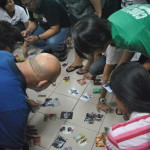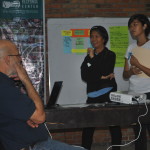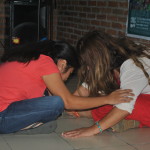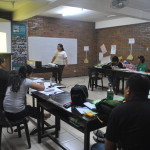Dec. 3, 2015 – A total of 15 representatives from the Citizens’ Disaster Response Center ( CDRC) and Citizens’ Disaster Response Network (CDRN) successfully completed the Psychosocial Training of Trainers conducted by the Israel Trauma Coalition (ITC) at the CDRC Conference Hall in Quezon City on Nov. 26-28, 2015. This activity was sponsored by the American Jewish Joint Distribution Committee (JDC).
CDRC) and Citizens’ Disaster Response Network (CDRN) successfully completed the Psychosocial Training of Trainers conducted by the Israel Trauma Coalition (ITC) at the CDRC Conference Hall in Quezon City on Nov. 26-28, 2015. This activity was sponsored by the American Jewish Joint Distribution Committee (JDC).
A continuation of the Psychosocial Intervention in Emergency Situations Training held last July, this activity aimed to: (1) refresh and deepen the participants’ knowledge of the models and tools taught in the previous training, (2) introduce new models of psychosocial concepts and, (3) support the participants in developing their own material and experience the training of others.
 In the discussion on the Essential Elements of Immediate and Midterm Trauma Intervention, Mr. David Gidron of ITC asked the trainees to separate into groups and come up with appropriate activities and services that will promote safety, calming, sense of self and collective efficacy, connectedness and instil hope among survivors of traumatic events. Another group activity also involved preparing local authority for a crisis. In this exercise, groups presented and “defended” their proposals for preparedness, immediate response and recovery to the “Mayor.”
In the discussion on the Essential Elements of Immediate and Midterm Trauma Intervention, Mr. David Gidron of ITC asked the trainees to separate into groups and come up with appropriate activities and services that will promote safety, calming, sense of self and collective efficacy, connectedness and instil hope among survivors of traumatic events. Another group activity also involved preparing local authority for a crisis. In this exercise, groups presented and “defended” their proposals for preparedness, immediate response and recovery to the “Mayor.”
ITC’s Ms. Armelle Lehman, on the other hand, introduced Pacing and Leading or usi ng language to influence positive behaviour among distressed persons. She also demonstrated how to conduct a supportive conversation by (1) becoming a physical mirror of the person’s tone of voice, body language, and/or silence, (3) creating a “Yes” set questions to establish rapport and secure his attention, (4) reframing or giving new positive meaning to his behaviour which is causing negative feelings, (5) neutralizing negative self-talk, and (5) helping him regain a sense of control by asking questions that allow him some choice. Ms. Lehman stressed that it is important to avoid disagreeing with the survivor’s perceptions. Instead, offering encouragement for every positive change is essential. Her input on Emotional Freedom Techniques (EFT) included tapping or pressing acupressure points and dancing.
ng language to influence positive behaviour among distressed persons. She also demonstrated how to conduct a supportive conversation by (1) becoming a physical mirror of the person’s tone of voice, body language, and/or silence, (3) creating a “Yes” set questions to establish rapport and secure his attention, (4) reframing or giving new positive meaning to his behaviour which is causing negative feelings, (5) neutralizing negative self-talk, and (5) helping him regain a sense of control by asking questions that allow him some choice. Ms. Lehman stressed that it is important to avoid disagreeing with the survivor’s perceptions. Instead, offering encouragement for every positive change is essential. Her input on Emotional Freedom Techniques (EFT) included tapping or pressing acupressure points and dancing.
 On the last day of the training, the trainees designed their own lesson plans based on their target audiences. They prepared their own materials and developed activities that will demonstrate the different channels of coping. After their workshop, the trainees became the trainers with support from the facilitators and lively participation of co-trainees who acted as their students.
On the last day of the training, the trainees designed their own lesson plans based on their target audiences. They prepared their own materials and developed activities that will demonstrate the different channels of coping. After their workshop, the trainees became the trainers with support from the facilitators and lively participation of co-trainees who acted as their students.
During the evaluation, the participants expressed satisfaction over the content and design of the training and its applicability in the workplace and in the communities. As a way forward, the trainees requested that the third part of the training be a practicum in distressed areas of the regional centers.

Leave a Reply